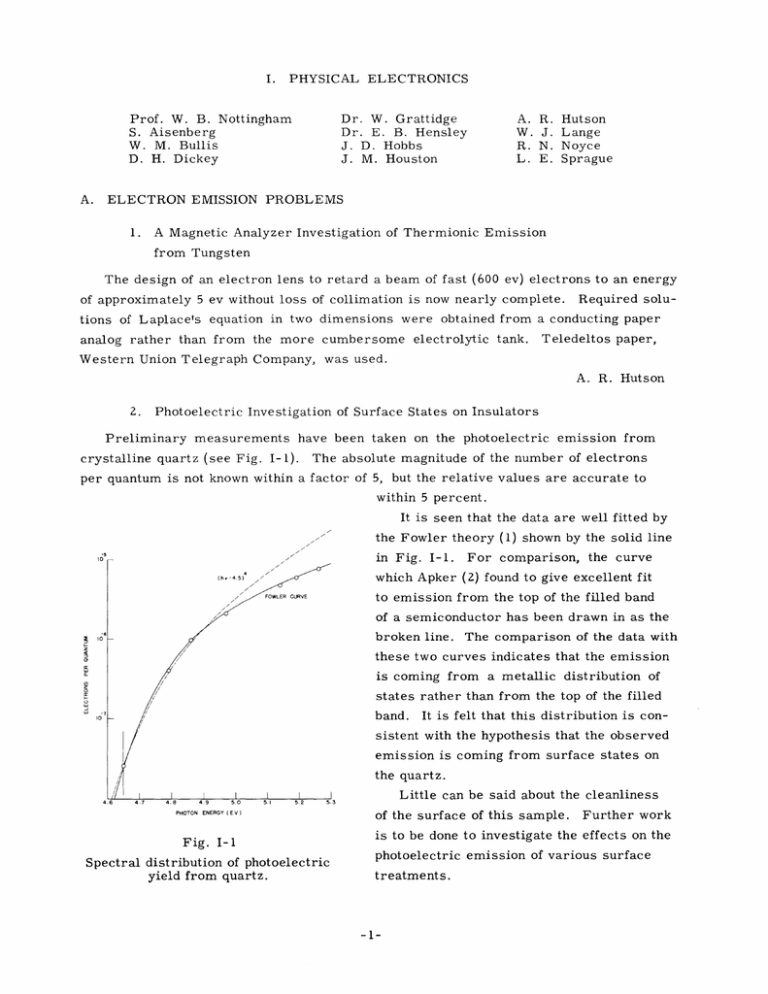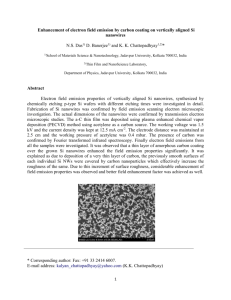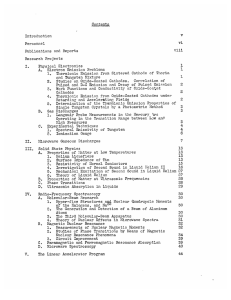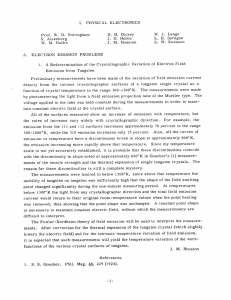I. PHYSICAL ELECTRONICS Prof. W. B. Nottingham
advertisement

I. PHYSICAL ELECTRONICS Prof. W. B. Nottingham S. Aisenberg W. M. Bullis D. H. Dickey A. Dr. W. Grattidge Dr. E. B. Hensley J. D. Hobbs J. M. Houston A. R. Hutson W. J. Lange R. N. Noyce L. E. Sprague ELECTRON EMISSION PROBLEMS 1. A Magnetic Analyzer Investigation of Thermionic Emission from Tungsten The design of an electron lens to retard a beam of fast (600 ev) electrons to an energy of approximately 5 ev without loss of collimation is now nearly complete. Required solu- tions of Laplace's equation in two dimensions were obtained from a conducting paper analog rather than from the more cumbersome electrolytic tank. Teledeltos paper, Western Union Telegraph Company, was used. A. R. Hutson 2. Photoelectric Investigation of Surface States on Insulators Preliminary measurements crystalline quartz (see Fig. I-1). have been taken on the photoelectric emission from The absolute magnitude of the number of electrons per quantum is not known within a factor of 5, but the relative values are accurate to within 5 percent. It is seen that the data are well fitted by the Fowler theory (1) i 4i I"-1 shown by the solid line JiT J, . ., the 11rT which Apker (2) found to give excellent fit to emission from the top of the filled band of a semiconductor has been drawn in as the broken line. M The comparison of the data with these two curves indicates that the emission o is coming from a metallic distribution of states rather than from the top of the filled o m a. band. It is felt that this distribution is con- sistent with the hypothesis that the observed emission is coming from surface states on the quartz. Little can be said about the cleanliness PHOTONENERGY(EV) Fig. I-1 Spectral distribution of photoelectric yield from quartz. of the surface of this sample. Further work is to be done to investigate the effects on the photoelectric emission of various surface treatments. (I. PHYSICAL ELECTRONICS) A change in the photoelectric threshold has been sought by varying the amount of charge on the insulator, but so far the results have been inconclusive. observable shift, and the above interpretation of the data is surface states is higher than has been previously proposed, If there is no correct, the density of and is greater than 1013 states per electron volt per square centimeter. A second measurement on fused quartz has been made, and it now appears that the threshold is at least 0. 5 ev higher than for crystalline quartz. R. N. Noyce References 1. R. H. Fowler: 2. L. Apker, 3. E. Phys. Rev. 38, Taft, J. Dickey: 45, 1931 Phys. Rev. 74, 1462, 1948 A Redetermination of the Crystallographic Variation of Electron Field Emission from Tungsten In order to study the electron field emission from a metal, the field-emitting electrode is usually made in the shape of a sharp point, so that the required high electric fields can be achieved at the point tip with reasonable applied voltages. In order to get a measurable amount of field emission from tungsten with an applied voltage of 10 kv, the apex radius of the point must be approximately 0. 5 or smaller. Such points are usually formed by either chemical or electrolytic etching of the blunt end of a wire. Electrolytic etching has an advantage in that electropolishing often occurs, producing smooth and symmetrical points. For use in this research an experimental technique has been developed for etching such points on 0. 003-inch tungsten wires immersed in sodium hydroxide solution. However, such a technique is still very much an art, and consistent results are not always obtained. It is hoped that a study of the theory of electrolytic etching and electropolishing will indicate how one should vary the many variables in the point-etching process in order to get easier and more reliable control of the process. In order to calculate the electric fields at the apex of a point, it is necessary to know in detail the shape of the point tip and the general shape of the rest of the point. An apparatus for optical photomicroscopy has been planned and partially constructed for taking pictures of the tungsten points. limited to around 0. 5 Since the resolution of an optical microscope is , an electron microscope must be used to see details of the tip. The mechanism for holding and positioning the tungsten points in an available electron microscope is being built. J. -2- M. Houston (I. 4. PHYSICAL ELECTRONICS) Conduction Mechanism in Oxide-Coated Cathodes Progress has been made during the past quarter on the problem of determining the Two tubes employing high-temperature conduction mechanism in oxide-coated cathodes. coaxially mounted, button cathodes have been constructed. In the first of these tubes the spacing between the opposing cathode surfaces was controlled by manipulating an iron slug within the tube by means of an external magnet. In the second tube a bellows A third arrangement was employed to impart the desired motion to the movable cathode. tube is now being constructed on the basis of experience gained from the first two. This type of tube has proved to be extremely versatile in the variety of information obtainable. Several criteria have been established to test the validity of the pore con- duction hypothesis for the high-temperature conduction mechanism (E. J. Appl. Phys. a. 23, 1122-1129, Oct. 1952). B. Hensley: These may be indicated briefly as follows: The degree of sintering of the porous structure may be increased by pressing the cathodes tightly together and raising their temperature to around 12000K. Since this will increase the degree of contact between the particles and decrease the communication between the pores, the pore conduction hypothesis predicts that the conductivity in the low- and high-temperature regions will be respectively increased and decreased. If we assume that the cathodes were fully activated at the start of the process, the slopes of the two regions should remain unchanged. Tentative confirmation of this effect has been obtained. b. If the conductivity of the cathodes is predominantly a property of the electron gas in the pores, it should not be necessary to extend the solid material continuously from one cathode base to the other. Thus, the fraction of current carried by the electron gas should be obtainable by comparing the conductance of the system with the cathodes slightly separated to that with the cathodes pressed together. For this result, however, the cathode separation used must be kept very small (less than 0. 1 mm) so that the current will not be reduced by a space charge forming in the gap. Tentative confirmation of this effect has also been obtained. c. A third method for testing the pore conduction hypothesis is to measure the ratio of the conductivity to the thermionic emission. double cathode tubes pressed together. The conductivity is measured with the The thermionic emission may be obtained by separating the cathodes and using first one and then the other as an anode. conduction hypothesis predicts this ratio to be of the order of 3 x 10 - 3 The pore cm/amp ohm. Measured values of this ratio still tend to be too large; several possible reasons for this are being studied. d. A fourth test involving filling the tube (and consequently the pores of the cathodes) with a chemically inert gas has been discussed in previous quarterly reports. We plan to resume this phase of the problem soon. E. B. Hensley -3- (I. PHYSICAL ELECTRONICS) B. PHYSICAL ELECTRONICS OF THE SOLID STATE 1. Temperature Gradients Across Ionic Crystals The establishment of a temperature gradient across the system silver - silver chloride - silver produces an emf, the magnitude of which depends on the temperature gradient and on the average temperature. During the quarter a series of measurements of this emf-per-unit temperature gradient has been carried out as a function of temperature for a temperature range of 1000C to 3500C. The emf was measured by using a vibrating-reed electrometer and the temperature gradient was measured by use of molybdenum-nickel thermocouples attached to the silver electrodes. However, in the temperature range 250'C to 350 0 C there occurs a transition region for nickel which affects its thermoelectric power and throws doubt on the accuracy of the temperature difference measurement taken with the use of the molybdenum-nickel couple. It is therefore proposed to use molybdenum-tungsten thermocouples and steps are at present being taken to calibrate such a couple against platinum - platinum rhodium. W. Grattidge C. EXPERIMENTAL 1. STUDIES Further Studies in Vacuum Techniques The omegatron, which has been previously reported, has been found to be impractical as formerly designed, and the construction of a new instrument of somewhat modified design is now being completed. Electric field mapping on Teledeltos resistance paper showed the rf field in our first omegatron to be so nonuniform that proper resonance of the ions produced in this field was not possible. A new tube has been designed in which the plate separation is decreased while the plates themselves are of greater area. It is the goal of this investigation to use the omegatron in analyses of the residual gases in high vacuums and through this approach to the problem to evaluate the existing limitations in attaining high vacuums. W. J. 2. Lange, J. D. Hobbs Ionization-Gauge Control Studies A simple and stable control circuit has been designed for use with the ionization gauge of the Bayard-Alpert type for the accurate and convenient measurement of very low pressures. The greater stability, of the circuit results from the fact that direct measurement of the i +/i_ ratio will give the pressure (i+/i_ = PK) without the need for stabilizing the electron current (i_). The latest version of the circuit (which is in the (I. process of construction) is shown in Fig. 1-2. PHYSICAL ELECTRONICS) The voltages Ri and R i are increments in voltage when compared to the zero-balance position with no electron and ion current flowing through their respective resistors. When the bridge indicates a null balance, R i = paRi_. g+ (1) Consequently, i P R- K a.(2) g Ki- The circuit is made direct reading for various values of the gauge constant K by adjusting the P control so that P/K remains constant. The ratio R/Rg is changed by a selector switch which serves as a range selector and also selects the appropriate electron current for that range. Thus, use of the circuit, after preliminary adjustment of a zero control, a gain control, and the control, involves only the use of two controls: P the range selector, and the a control. -A The pressure is then directly read off in the form P = a x 10 The null bridge is sensitive enough to permit a to be measured to 1 percent at full -l scale when the gauge constant K is equal to 20 mm -1, with the accuracy increasing as K increases. Thus the limitation of the accuracy of the pressure measurement is mainly determined by the accuracy of the resistors used in the circuit and the accuracy with which the gauge constant K is known. S. Aisenberg, D. H. Dickey Fig. I-2 Block diagram of control circuit. -5-





